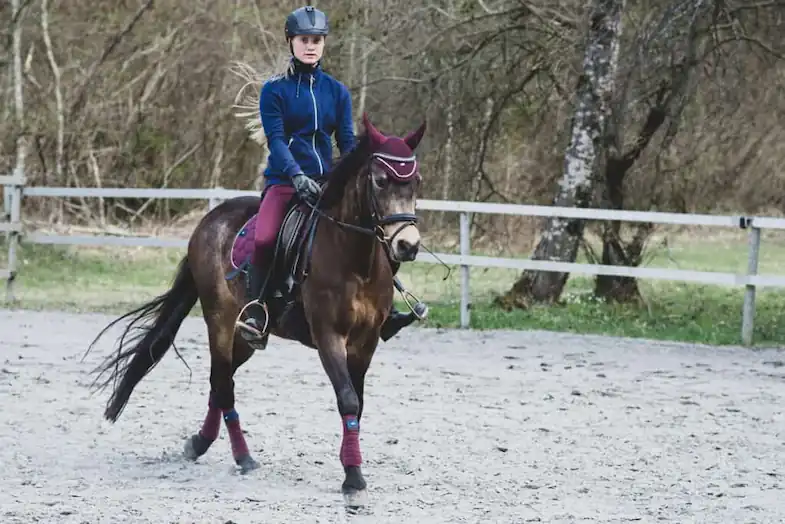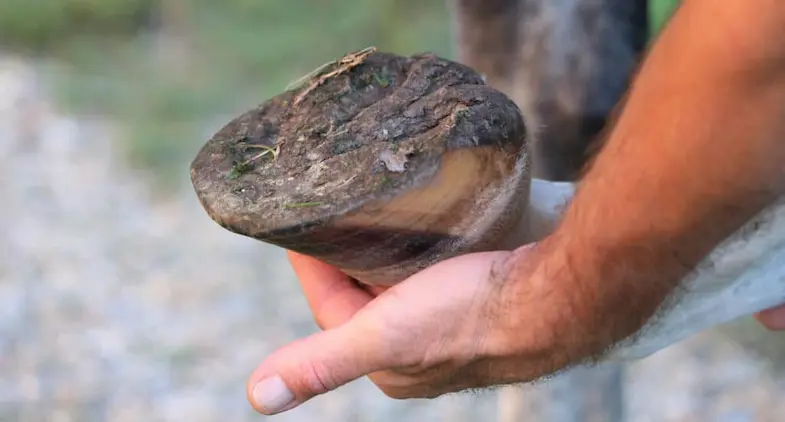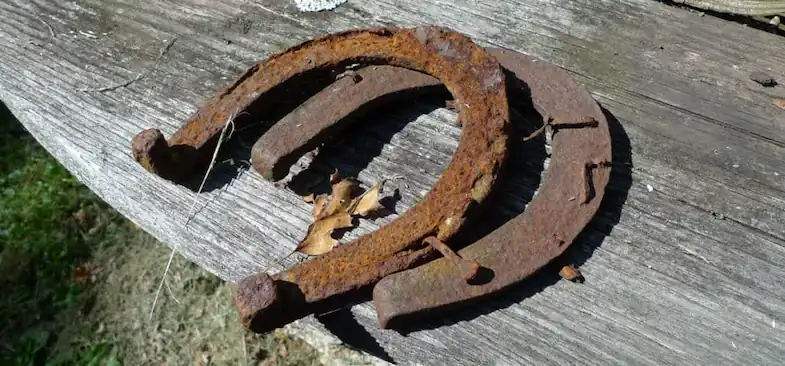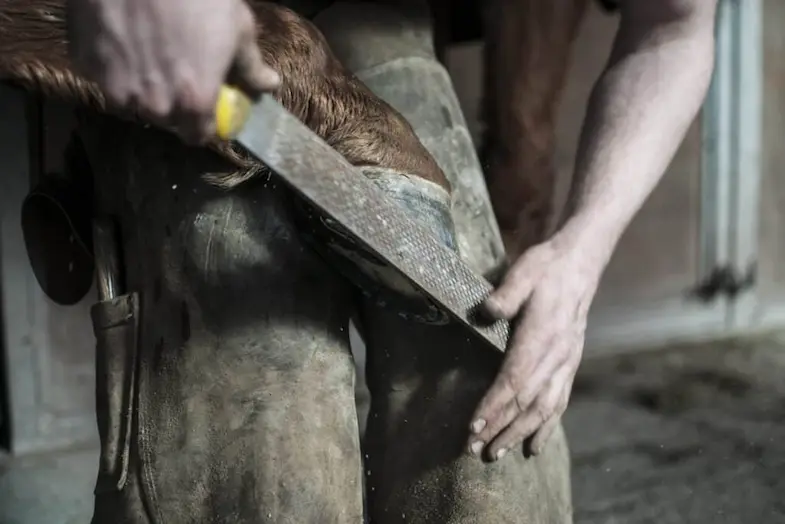If your horse loses a shoe while you’re out riding you’re not necessarily going to notice immediately so there will be a period of time that you continue riding for but the question is more ‘can you continue to ride KNOWING your horse has a shoe missing’? Over the years I’ve had many occurrences of missing shoes and have had to call the farrier way too many times to remember. Of course, I’d rather this never happened but the fact that it has means that I’ve got a lot of experience on the matter which is why I decided to write this article.
As a general rule, you should stop riding your horse immediately when he loses a shoe in order to prevent further damage, pain, or discomfort. That said though if you have a soft sandy arena and your horse isn’t lame you can continue to ride him because the sand won’t cause further harm to the hoof.
It can be frustrating and inconvenient when your horse loses his shoe mid-ride but it doesn’t need to be a disaster. In an ideal world this would, of course, never happen but last time I checked it certainly wasn’t an ideal world so we just have to accept that from time to time your horse may well lose his shoe, but the good news is that it doesn’t automatically mean you have to stop riding until your farrier has refitted or replaced the shoe.
Should you still ride when your horse loses a shoe?
If the shoe has completely (and cleanly) fallen off, there are no nails still in your horse’s foot and the hoof itself is entirely intact with no cracks, then in some circumstances, you can still ride. I say ‘in some circumstances’ because, even if your horse’s hoof appears to be fine, you shouldn’t act as if everything is okay and carry on as normal. While horses obviously can live happily without shoes (after all how many wild horses do you see wearing them), wearing them on three feet (or just one) will unbalance your horse and, if you ride normally can put unnecessary strain on his joints and lead to pulled muscles.
You should keep your riding to a minimum if possible and only ride on soft, forgiving ground that will act to cushion your horse’s foot, the ideal surface for this is a sandy arena. You should never jump your horse if he’s lost a shoe though, even if the ground is soft because the impact of your horse hitting the ground could lead to further damage as well as put unnecessary (and uneven) pressure on his joints and muscles. It’s also important to keep any riding gentle and only walk or jog/trot your horse.
Like all animals, horses are independent creatures with a mind of their own so will also have a say as to whether or not you can ride. Some horses will happily carry on with a missing shoe while others will go into a complete meltdown and act as if they’ve lost their whole leg.
Is it serious when a horse loses a shoe?
While it might be frustrating when your horse loses a shoe especially if you have a competition coming up, if dealt with promptly, it’s unlikely to be serious. If you don’t look after and protect the hoof then there is always the risk of it becoming infected which can lead to more serious problems such as abscesses.
To prevent your horse’s hoof from becoming infected it’s crucial that you keep it clean, protected and call the farrier as soon as possible.
What should you do if your horse loses a shoe while you’re riding?
If your horse loses his shoe while you’re out riding you should dismount straightaway (or at least as soon as you notice it) and assess the situation. Continuing to ride without checking the state of your horse’s hoof could be a recipe for disaster, especially if the shoe is hanging, or nails are embedded in the hoof. Instead, get off and follow these simple steps.
Check the hoof
It’s important to check the general condition of your horse’s hoof and to see if it’s damaged at all. You should be looking out for any cracks that could let bacteria in as well as look for any missing chunks of the hoof that came off with the shoe. Nails can go straight through the sole of the foot if the shoes twists as it comes off so it’s important to look for puncture wounds too and treat them accordingly.
Remove any nails
Your horse may have lost his shoe but the nails could still be in his hoof so you need to remove this if possible. To do this use a strong pair of pliers or nail pullers to get hold of the nail head and out from the sole of the hoof. Never try and remove them from the wall of the hoof. Looking at the shoe on the opposite hoof will help you to know how many nails to look for.
If you’re not sure if you’re okay to remove the nails then leave them and speak to your veterinarian or farrier for guidance first, they’ll be able to help advise you of what to do.
PLEASE NOTE: If the shoe is partially attached you should NEVER try and remove it yourself unless you’re a trained professional. Horses have a lot of nerves, blood vessels, and tissue in their hooves so it’s important you know what you’re doing.
Protect the hoof
If you have a hoof or turn out boot then you should put that on your horse’s hoof until the farrier arrives. When a horse loses a shoe the hoof can sometimes start to break apart, increasing the risk of infection. Using a hoof boot will help to keep it together and reduce the chances of infection getting in.
Don’t worry if you don’t have a hoof boot you can use a diaper instead, this will work just as well and will also give your horse a little bit of cushioning too. While most diapers do have their own fastenings it’s best to use duct tape to secure it around your horse’s hoof.
Pick up the shoe/nails
If you know where the old shoe is you should pick it up, along with any nails, and dispose of them all safely. You might not think this matters as your horse won’t need it anymore but leaving old shoes and nails around could present a hazard for another horse if they were to tread on them.
Call your farrier
Once you’ve accessed your horse you should call your farrier and explain what has happened. They will then arrange to re-shoe your horse. Don’t worry if they can’t come straight away, they will be able to give you some advice on keeping the hoof clean and your horse happy until they can.
PLEASE NOTE: While it can be frustrating when your horse loses his shoe it’s a natural occurrence and not your farrier’s fault so don’t go getting annoyed with them.
How can you prevent a horse losing a shoe when you ride?
While it’s practically impossible to completely prevent your horse losing a shoe there are a few things you can do to reduce the chances of this happening while you’re out riding.
- Be mindful of where you ride – Muddy ground can slow your horse’s movement down which means that he’s more likely to lower his hind feet before his front feet have left the ground, increasing the chances of him inadvertently pulling at the back of a shoe.
- Use overreach boots – Using boots that are a size too big will cover the heels and therefore reduce the chance of your horse stepping on the shoes, even if the ground is muddy. You can leave the boots on when your horse is turned out too but just make sure you remove them regularly to check for signs of rubbing.
- Don’t overwork your horse – Horses are no different to us and are more likely to trip over their feet if they’re tired.
- Keep your horse’s hooves clean – Cleaning your horse’s hooves every day (as well as after every ride) will reduce the chances of dirt and debris getting under the shoe and working it loose.
- Check your horse’s diet – If your horse has a high starch diet or mainly eats grass then his hooves could become brittle or dry, increasing the risk of them cracking and your horse losing a shoe. Speak to an equine nutritionist to make sure your horse isn’t missing anything from his diet.
- Have your horse shod regularly – Depending on your horse’s workload and how much you ride, you should have your horse checked by the farrier every 4 to 6 weeks regardless of how the shoes look. All horse’s hooves grow at different rates so it’s important to take your farrier’s advice on how often your horse should be shod.
What the experts say
When it comes to looking after your horse’s shoes and ensuring that they last Suzanne Reeves of Reeves Farrier Service from Jerome, ID has some very useful advice. When asked what owners can do to help the shoes stay on, she said that “owners need to be aware of the condition of their horse’s hooves and that if they’re thin-walled or overly dry and crumbly or too soft its harder for the shoes to hold” but Suzanne added that a good quality supplement can really help them to grow strong, better quality hooves.
Suzanne went on to say that the way a horse is ridden can also contribute to the loss of a shoe, particularly if the horse is making “sharp, sudden turns or stopping hard and fast“. She explained that this can put a lot of shear force on the nails.
An interesting point that Suzanne left us with was that if your horse is stomping a lot to get rid of flies this can also work to loosen your horse’s shoes. This is why you need to deal with flies, mosquitoes, and other biting insects as soon as possible, after all, prevention is better than cure.
If you’re in the Jerome area of Idaho you can contact Suzanne at Reeves Farrier Service on 208-539-5284.
Further reading
- Lost a shoe when riding?
- 13 reasons why your horse may trip
- Why is my horse pawing the ground?
- Staying safe while riding in snow
- How hard can a horse kick?
- When should you retire a horse?
I hope you found this article helpful. If you did I’d be grateful if you could share it please as it would really help me.
Recommended products
Over the years I have tried hundreds of different horsey products, from various blankets and halters to different treats. Some I’ve loved, others I’ve hated but I thought I’d share with you my top all-time favorite products, the ones I never leave the yard without. I’ve included links to the products (which are in no particular order) that I really think are great.
- Horse Knots by Reference Ready – If you’re like me and enjoy pocket reference guides then you’ll love this knot tying guide. These handy cards can easily fit in your pocket or attach to the saddle for quick reference. They’re waterproof, durable and are color coded to make them easy to follow.
- Mane ’n Tail Detangler – Even if you never show your horse you’ll need to detangle his tail from time to time (and possibly his mane too) which is always a challenging chore! I’ve found that if I run a little bit of detangler through my horse’s tails every few days it stops them from getting matted up and makes combing them easy, even if they’re coated in mud. I don’t know if I should admit to this or not but it also works wonders on my hair.
- TAKEKIT Pro clippers – Over the years I’ve tried a lot of different clippers and while some were obviously better than others I found these to be by far the best. They are heavier than a lot of other clippers but for me, that’s a good thing, it makes them feel more sturdy and hardwearing. On top of that they have a range of speeds so are just as good for clipping your horse’s back as they are his face. I also like the fact that they come in a handy carry case but that’s not for everybody. The company that makes them is super good and incredibly helpful too, a real bonus these days. The only thing I wasn’t keen on was the fact that it doesn’t come with any oil, but that’s not a major problem as it’s not difficult to buy lubricant.
- Shire’s ball feeder – There are so many boredom buster toys out there but I like to use these every day, regardless of whether or not my horses are bored. I find that it helps to encourage my horses to problem solve by rewarding them with treats (or pieces of fruit) but it also mimics their natural grazing behavior which helps to keep them calm and de-stressed.
- Horse safe mirror – This is a strange one that many people are surprised about but I like to put horse safe mirrors in the trailers as well as in the quarantine stalls. It helps to prevent the feeling of isolation by giving the impression of other horses being around. Being herd animals horses can get extremely stressed when they feel that they’re on their own but with these stick-on mirrors, they believe that at least one other horse is with them.
- Rectal thermometer – I know this isn’t glamourous at all but it’s vital for your horse’s well-being to be able to check their temperature and a rectal thermometer is the easiest way of doing this which is why I’ve added it to the list.
Shopping lists
I’ve also put together a few shopping lists of essential items that I’ve found helpful over the years. I’ve broken the lists down into different categories rather than put everything in one massive list 😉





